Sao Paulo is the largest city in Latin America, and the 9th largest in the world, with approximately 12 million inhabitants. It’s not very touristic and more of a business hub. You’ll find typical Brazilian foods around every corner, while coffee is the most popular drink in Sao Paulo. Opt for the freshly brewed Brazilian coffee beans instead of highly processed coffee powder. Meanwhile, for a fun nutrition boost, try our Coffee-Spinach Smoothie recipe.
Contents
- 1 Sao Paulo Municipal Market (“Mercado Municipal”)
- 2 Exotic Grocery-store Fruits
- 3 Rua Augusta: Vegan Street of Sao Paulo
- 4 Sao Paulo Gyms
- 5 Sao Paulo’s Japanese neighborhood
- 6 Sao Paulo’s Other Neighbourhoods
- 7 Transport in São Paulo
- 8 Where to Stay in São Paulo
- 9 The Health Travel Junkie Challenge for Sao Paulo
- 10 Health Travel Junkie Scale
- 11 Useful Brazilian Portuguese words
Sao Paulo Municipal Market (“Mercado Municipal”)
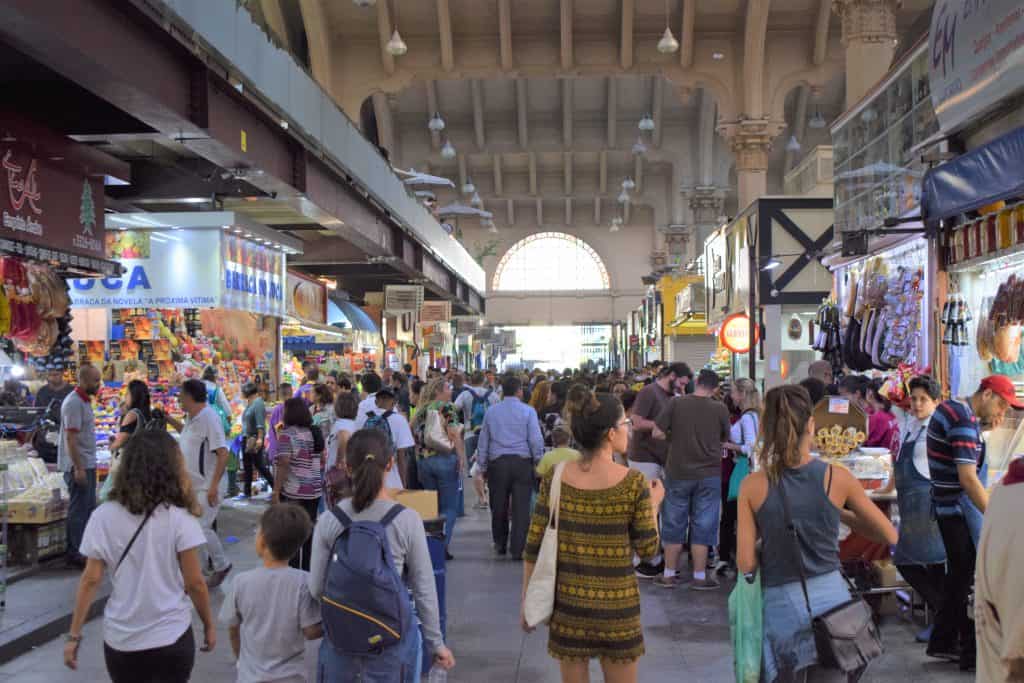
Sao Paulo’s municipal market always comes up in tourist recommendations. However, there’s a few negative factors (“cons”) to be aware of
Mercado Municipal Cons
- You are rarely told how overpriced the market’s fruits are. An insider tip to sample Brazilian exotic fruit and veg at reasonable prices, is to rather visit Sao Paulo’s regular fruit & veg supermarkets – Hortifruti is a great choice.
- Another negative about the municipal market is hygiene. They use the same knife and hands to cut off the piece of fruit and give it to the customer.
- Even worse, the vendors of these overpriced fruits get aggressive to sell their products, by coming up to you when you are walking far away, being manipulative, and touching your shoulder while you’re not even looking in their direction.
- This food market is not in a great neighborhood. Outside, there are beggars and vagrants. On the flip side, it most likely has the widest variety of exotic fruit in São Paulo underneath the same roof. Although the prices are a rip-off.
Recent Improvements
In 2019 I noted a few positive changes. There was police presence outside the market, which is good since its a bad neighborhood. Inside it felt reasonably safe, and I could take photos openly with my camera without problems. During 2015, I remember the fruit that was sold at sky-high inflated prices. Unfortunately, in 2019 this is still the case.
In 2015 the focus of the market was mostly fruit. But it seems they have diversified nowadays with a wider variety of products in the market. This includes herbs, spices, fish, cured meats, olives, artisanal cheese, and other natural products which are being sold at reasonable grocery store prices. Here and there you’ll notice fruit with the price very clearly displayed. In these cases, the prices were mostly decent and honest. Nevertheless, 90% of the fruit sold here does not have prices openly displayed, and is way overpriced.
Not as authentic
Compared to the markets of other Brazilian cities, Sao Paulo’s Municipal Market is not nearly as good and authentic. For example, at Belo Horizonte‘s Market, the prices are actually better than at grocery stores. While in Sao Paulo it’s the other way around.
It seems, that by
- wrapping up each individual fruit in some paper (which is wasteful of packaging), then
- giving the customer a small piece of fruit and a taste experience before the sales pitch, they try to justify charging some random insane price. The second time around, I didn’t fall for the free tasters.
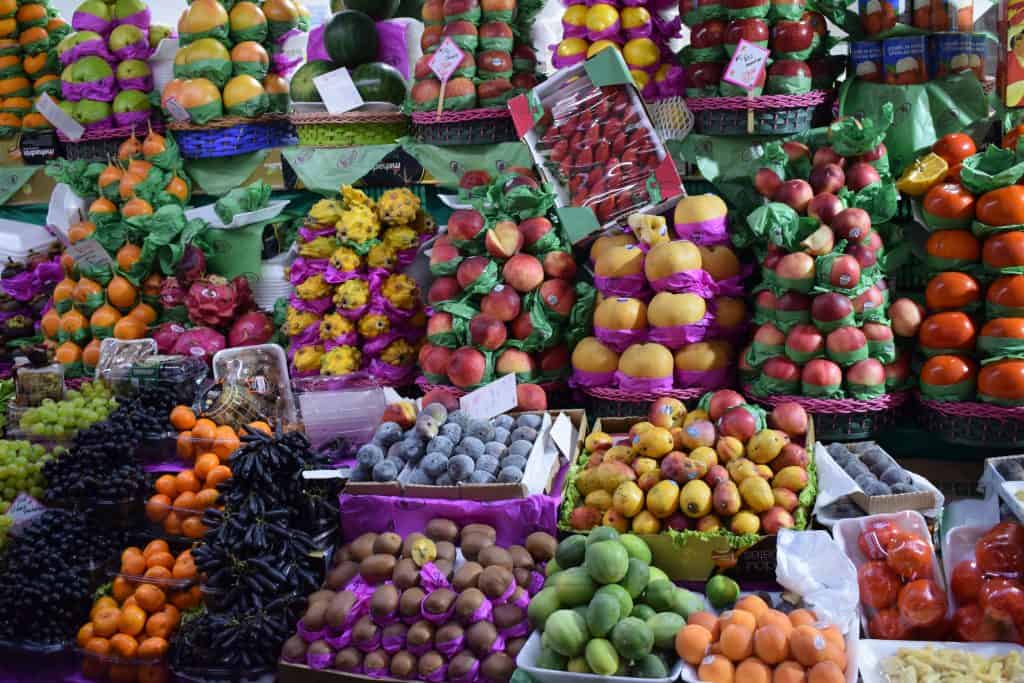
Another negative is there weren’t a lot of freshly squeezed juices available. However, you’ll find fresh coconut water for 5 Reals right outside the market.
Apart from the few interesting, but over-priced, regional food products, I suspect they’ll keep on diversifying from the expensive fruit scam. Maybe in the future they’ll start selling all the fruit at fair and competitive prices. For now, it’s a “tourist trap” to be careful with.
Exotic Grocery-store Fruits
To give you an idea of the types of fruit available at the local fresh fruit and vegetable store, see the pic below. A popular exotic fruit in Brazil is the Chirimoya or custard apple (green fruit in the middle in the pic). Along with the sweet, creamy white flesh, there are plenty of hard black seeds in this fruit. Take note that you are not supposed to eat the black seeds as it contains small amounts of poison. However, you are not that likely to fall ill if you accidentally swallow one or two seeds, since the seeds have a hard shell. This allows it to simply pass through your digestive system. Yet, if you decide to make a Chirimoya smoothie, you’d have to painstakingly remove every seed from the flesh, before you blend the white pulp.
Another fruit which is a must to sample is the Cashew-apple (bottom right in the pic below). Sticking out of this fruit is the cashew nut, which in this case is not edible, but the fruit itself is. It is very juicy, and thus Cashew-apple juice is widely available in Brazil. Top left is Acerola berries. These small red fruits are very high in Vitamin-C and are often sold as a supplement in powder form at health shops. The pink fruit is dragonfruit. It’s more common nowadays in local grocery stores. While the tiny mango at the bottom is good for snacking. Lastly, the top right orange fruit is Seriguela. According to Flavors of Brazil, the soft skin of this fruit surrounds a “not-too-sweet but very aromatic pulp that melts in the mouth and is very juicy. The flavor has hints of mango and caja.”
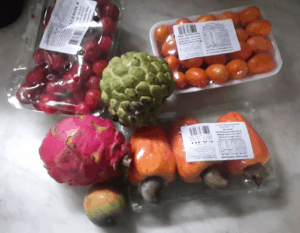
Also check out the Brazilian Pine nut (Pinhao) in larger grocery stores. It’s a local delicacy which looks like a huge pine nut, but gets prepared like chestnuts (photo in pine nut health benefits post).
Rua Augusta: Vegan Street of Sao Paulo
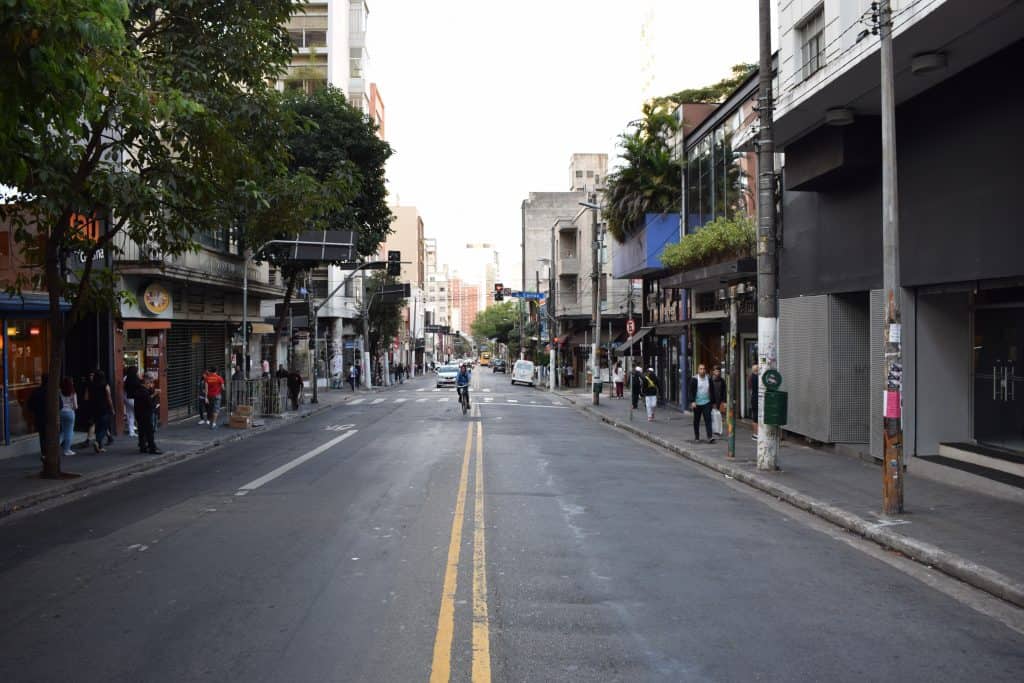
At Augusta Street almost all the restaurants (and even the snack bars) are vegan and vegetarian-friendly. They mostly use soy to substitute meat (along with here and there Seitan Wheat Gluten). Vegan and vegetarian options at Rua Augusta include soy vegan hotdogs at the Hot Dog Company in Galeria le Village. Then there are the vegan pastries at Sabor Mate, for which they tend to use healthier wholegrain flours. You’ll find vegan (mostly soy) Mexican Food at Tollocos Burritos. There are more Mexican options at Taqueria La Sabrosa. In this restaurant, the food is tasty with much less soy. But the negative is that the portions are very small.
Maoz Falafel used to be a great vegan option in this area, but they closed down during the scamdemic. Now, at Maoz previous location, there’s a very good all-you-can-eat buffet restaurant: Manai Gastronomia. However, this one is for meat-eaters.
Further down in the road, there’s different types of street food in the food truck area at Boardwalk Urbanoide, which is especially lively at night (except Mondays). Walking even further down (in the road parallel to Augusta – Rua Frei Caneca), there’s a wholefood shop: Olive Natural, with typical Brazilian wellness products. Lastly, you’ll notice similar vegan influences at restaurants & cafes in the side streets of Rua Augusta. For example, vegan pizza, hamburgers, and kebabs made with eggplants and mushrooms, instead of meat.
One such street is Rua Antonio Carlos, with the artisanal Empanada shop: La Guapa. Try the healthy vegan Empanada option made with spinach. Otherwise a free-range chicken empanada. Or Let’s Poke for their fresh Hawaiian seafood bowls and salads. Plus there’s one or two Indian vegan options as well.
Acai Smoothies
As in other cities in Brazil, Sao Paulo (including Rua Augusta) has plenty of Acai smoothie and -bowl options. However, Acai doesn’t necessarily have more nutritional value than other berries such as strawberries, blueberries, and blackberries. Like these, it is healthy and does contain anti-oxidants. However, there are conflicting studies about the extent of the nutritional benefits (it gets hyped up a lot). If you add an appropriate sweetener, it tastes good.
An awesome 2-ingredient Brazilian smoothie recipe is to mix up a banana with a packet of frozen Acai pulp, which you can buy in local grocery stores, in a blender. Add some water for a smoother consistency. This is the healthiest way of preparing an Acai drink. On the other hand, the Acai they sell at the Kiosks in Brazil can lead to weight gain, since they sweeten it with Guarana syrup (which is high in calories).
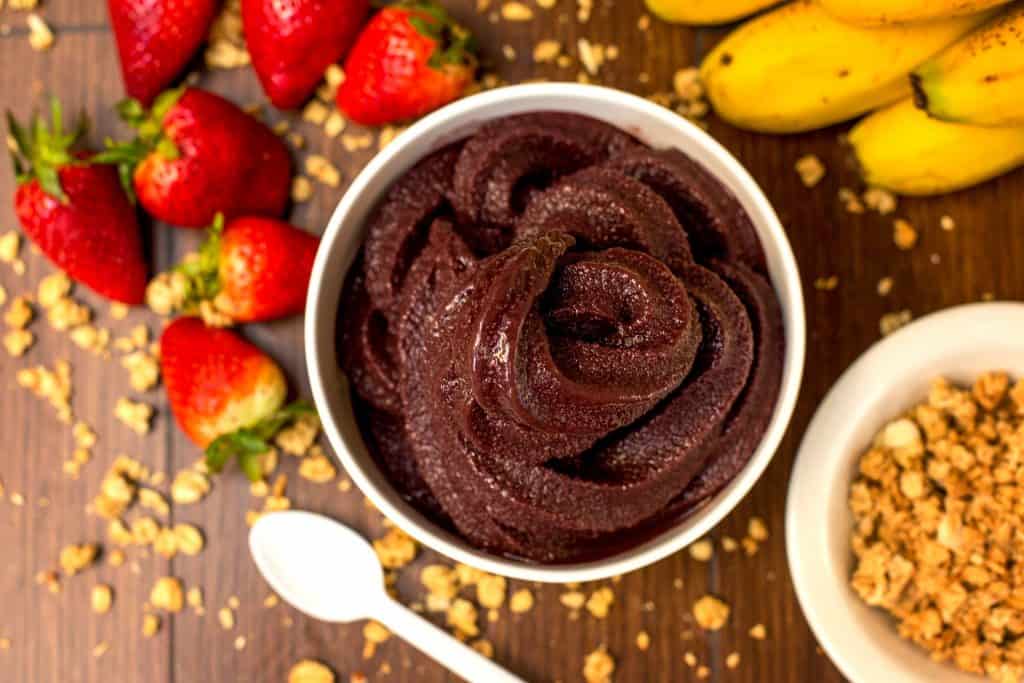
Sao Paulo Gyms
Smartfit is one option, but unlike in Rio de Janeiro, not all of their branches are tourist-friendly. For example, the branch in Rua Augusta doesn’t offer a day (nor week) pass. In Avenida Paulista, there are other Smartfit’s that do offer day passes. However, for tourists, Bluefit seems like the best option. For example, the Rua Frei Caneca 1173 branch (right next to Rua Augusta), is open 24 hours per day, 7 days a week, for 20 Reals per workout. But do take note that during Saturday and Sunday nights, there is no cashier in the office and thus no day-passes are available. With some luck, you may still get free entry – as a trial workout. It’s a large gym, with plenty of new machines, and a lot of space. The running treadmills has a nice view of Rua Frei Caneca on the outside.
In Pinheiros neighborhood, Bio Fitness will cost around 35 Reals for a gym session. However, they gave me my first workout free, as a trial. They allow members to bring along guests to their gym. Thus, my Airbnb host took me along one evening for my second free workout. The third time I paid. It’s a pretty good, upmarket gym with new equipment and fitness classes. If I lived close (in Pinheiros), I would have joined their gym for a longer period of time.
On Sundays, Avenida Paulista is shut for traffic, thus it’s pleasant for walking or cycling.
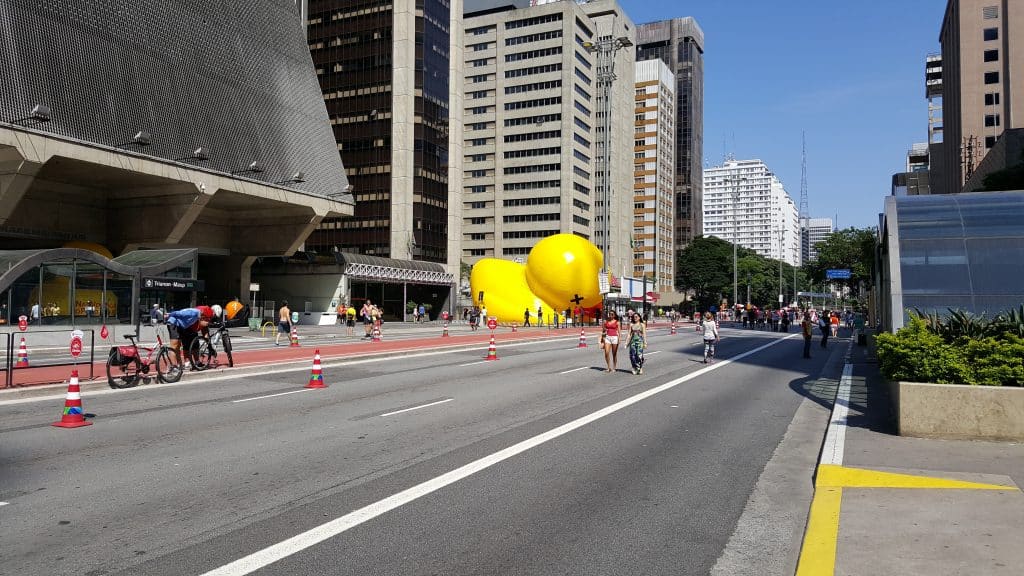
Sao Paulo’s Japanese neighborhood
One of the more interesting tourist attractions in Sao Paulo is the Japanese neighborhood at Liberdade. This is the largest Japanese community in the world, outside of Japan. Here you’ll find a few reasonably-priced ethnic Japanese restaurants and supermarkets – with unusual products. Notice the unique Japanese red street lights visible throughout the neighborhood.

The easiest way to reach this area of Sao Paulo is by Metro Train to Liberdade station. Right outside this Metro (Praca Liberdade), on Saturdays and Sundays, there’s a large Japanese Market. Expect a mix of Brazilian and Japanese food stalls. This is one of the nicest areas in Sao Paulo to visit over the weekend, and it can get very crowded.
Sao Paulo’s Other Neighbourhoods
Other neighborhoods in Sao Paulo include, for example, Vila Madalena, which is a little more expensive and upmarket than Rua Augusta. Vila Madalena is known for its nightlife and has plenty of bars and clubs. In the daytime, you’ll find one or two healthy restaurants like Banana Verde (with a very decent looking, but not cheap, lunchtime set menu). Plus, there is Casa Organica, a large organic health store. This is also the neighborhood where you’ll find the tourist attraction: Batman Alley (“Beco do Batman”), well-known for its graffiti.
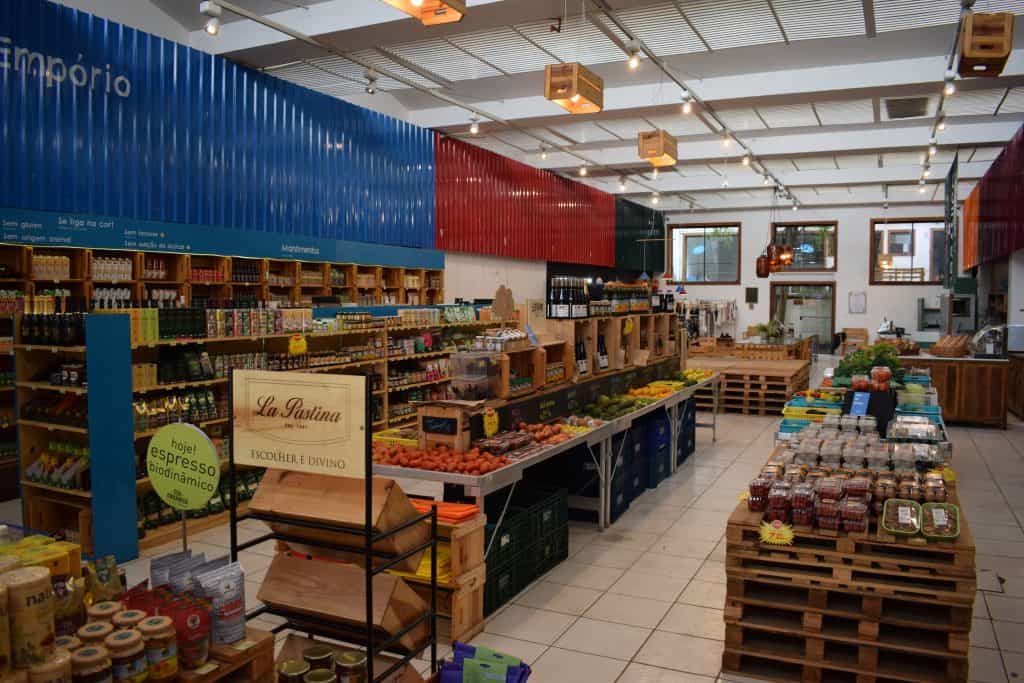
The Pinheiros Municipal Market is an upmarket and reasonably priced alternative (in Vila Madalena), to the above mentioned Central Market. It’s much smaller, but also safer, with grocery store prices for the fruits and vegetables.
On the other hand, Vila Mariana is mostly residential. There is a weekend vegan market, “Vegan Park”, but it was completely dead when I visited in Winter, with only 1 or 2 stalls.
Similarly, Bixiga is claimed to be the Italian neighborhood of Sao Paulo. But there’s really nothing special to do or see, it is simply another scruffy neighborhood.
Itaim Bibi is the part of Sao Paulo where many large companies are headquartered. It’s an expensive area, best avoided if you’re on a budget. There are good nightlife options in this part of town, but otherwise, it is not touristic.
Transport in São Paulo
For transport, the city has a good metro train network. It’s also well-connected to other Brazilian cities via bus or plane. One caveat is to be careful with taking the overnight bus to Iguazu Falls from Sao Paulo – this is known as the most dangerous bus route in Brazil. Especially since these buses are thought to be transporting “rich tourists at night”. However, the shorter 6-hour bus to Rio de Janeiro felt safe since it’s a daytime bus route. Similarly, in the south of Brazil, between Porto Alegre and Sao Paulo, I’ve taken plenty of night buses and never had any problems. For trips within the city, the “99 taxi app” is useful and less expensive than regular taxis.
Where to Stay in São Paulo
For accommodation, Hotel Belas Artes São Paulo seems like a very good choice. Apart from being next to the vegan street, Rua Augusta, it’s also very close to the touristic Avenida Paulista. Plus, it is very close to the Metro station “Consolação”. Lastly, there is a Gym inside the Hotel. If you can afford this 4-star hotel, I’d give it a go.
The Health Travel Junkie Challenge for Sao Paulo
Try out at least 3 or 4 exotic fruits that you have not tasted before. If you make an effort to visit different grocery and fruit/veg retailers, you’ll find a greater variety of exotic fruit or vegetables to sample.
Health Travel Junkie Scale
Fitness activities – 9
(Its a large city with plenty of fitness and sport options.)
Food – 8
(Food can be too expensive in the upmarket areas such as Vila Madalena or Itaim Bibi, but Rua Augusta has quality healthy food options at good prices.)
Cost of traveling – 8
(Depends which neighborhood you stay in. Staying in an expensive neighborhood is more likely to burn a hole in your wallet.)
Other Health-related activities – 6
(Not much else available apart from what’s mentioned above)
Overall rating: 77.5%
Useful Brazilian Portuguese words
Exotic fruit: Frutas exóticas
Vegetables: Legumes
Health Food: Comida saudável
How much does it cost?: Quanto custa?
A street is referred to as a “Rua”, while an Avenue is “Avenida”.
Is it vegan?: é vegan?
Is it vegetarian?: é vegetariano?
Does it contain milk / lactose?: Contém leite / lactose?
Is it gluten-free?: é sem glúten?
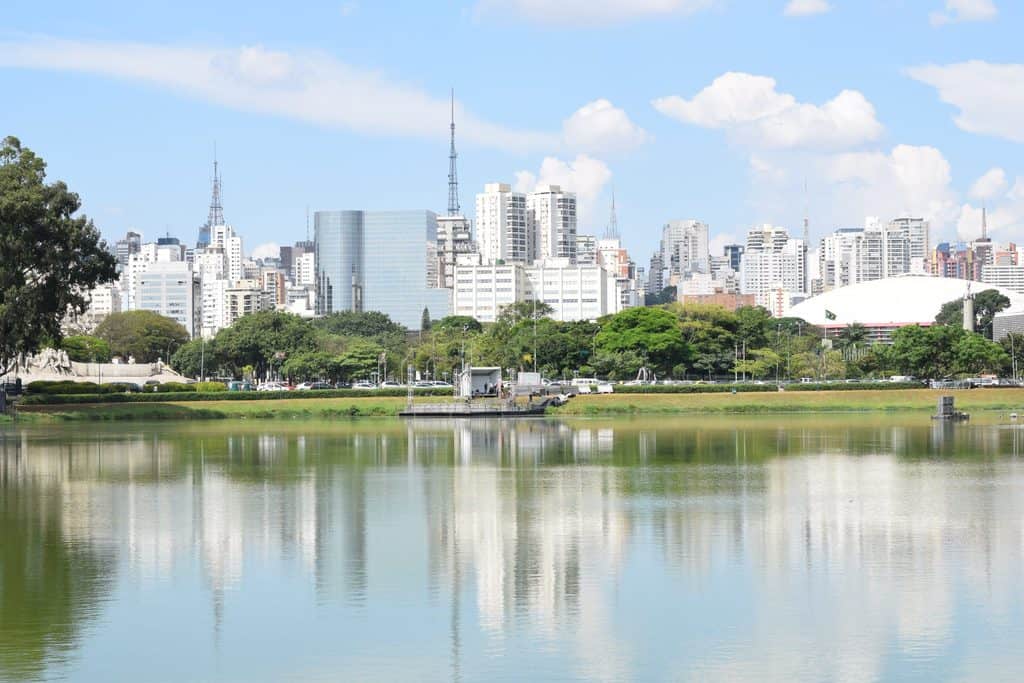
Have you ever been to São Paulo? If you have any other tips for wellness travelers (or questions), comment below!

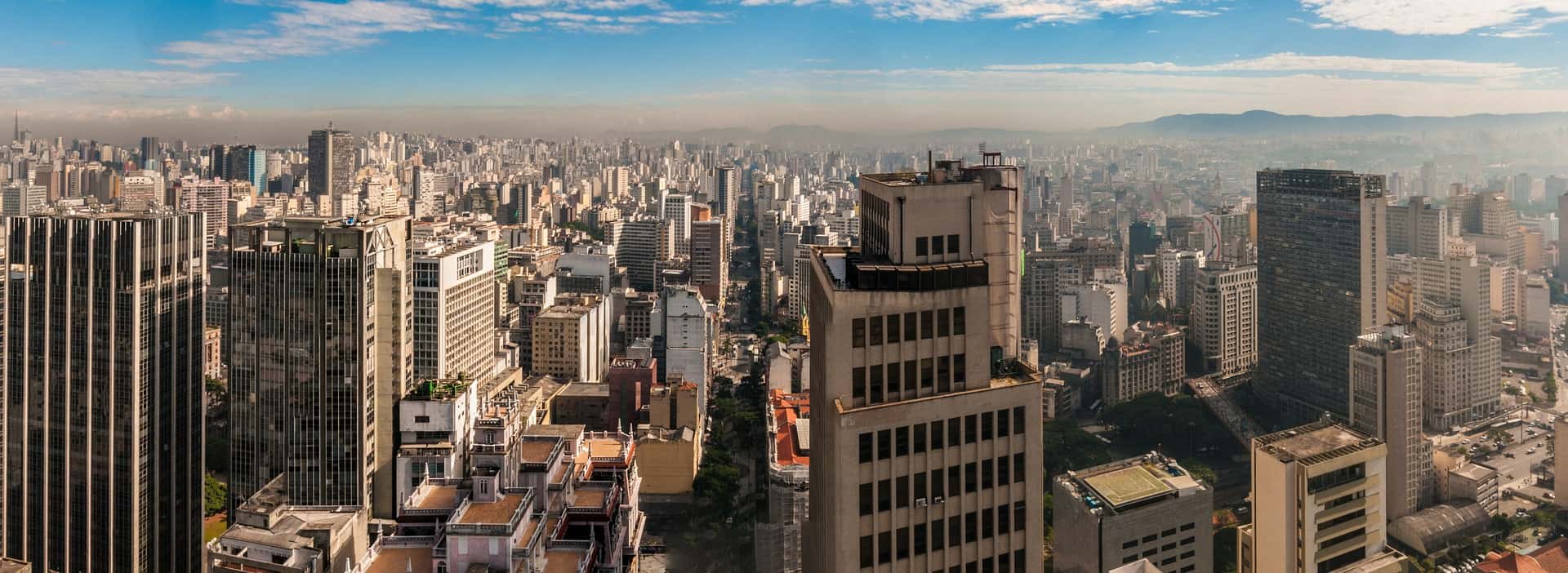
Thank you so much for providing this information. It is a long often overlooked topic It is quite.
It can be hard to be healthy on a vacation, especially in a country where most restaurants involve lots of barbecued meat.